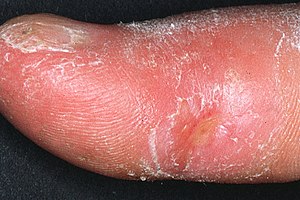Systemic sclerosis
| Systemic scleroderma | |
|---|---|
 |
|
| Clinical appearance of acrosclerotic piece-meal necrosis of the thumb in a patient with systemic sclerosis. | |
| Classification and external resources | |
| Specialty | rheumatology |
| ICD-10 | M34 |
| ICD-9-CM | 710.1 |
| OMIM | 181750 |
| DiseasesDB | 12845 |
| MedlinePlus | 000429 |
| eMedicine | derm/677 ped/2197 |
| MeSH | D012595 |
Systemic scleroderma, also called diffuse scleroderma or systemic sclerosis, is an autoimmune disease of the connective tissue. It is characterized by thickening of the skin caused by accumulation of collagen, and by injuries to small arteries. There are two forms of scleroderma: localized and systemic. The localized (limited) form affects the skin of only the face, hands, and feet. The systemic (diffuse) form involves those and, in addition, may progress to visceral organs, including the kidneys, heart, lungs, and gastrointestinal tract. Prognosis is determined by the form of the disease and the extent of visceral involvement. Patients with limited cutaneous scleroderma have a 10-year survival rate of 75%; less than 10% develop pulmonary arterial hypertension after 10 to 20 years. Patients with diffuse cutaneous scleroderma have a 10-year survival rate of 55%. Death is most often caused by lung, heart, and kidney involvement. There is also a slight increase in the risk of cancer.
Survival rates have greatly increased with effective treatment for kidney failure. Therapies include immunosuppressive drugs and, in some cases, glucocorticoids.
CREST syndrome (calcinosis, Raynaud's phenomenon, esophageal dysfunction, sclerodactyly, and telangiectasia) is associated with limited scleroderma. Other symptoms include:
...
Wikipedia
